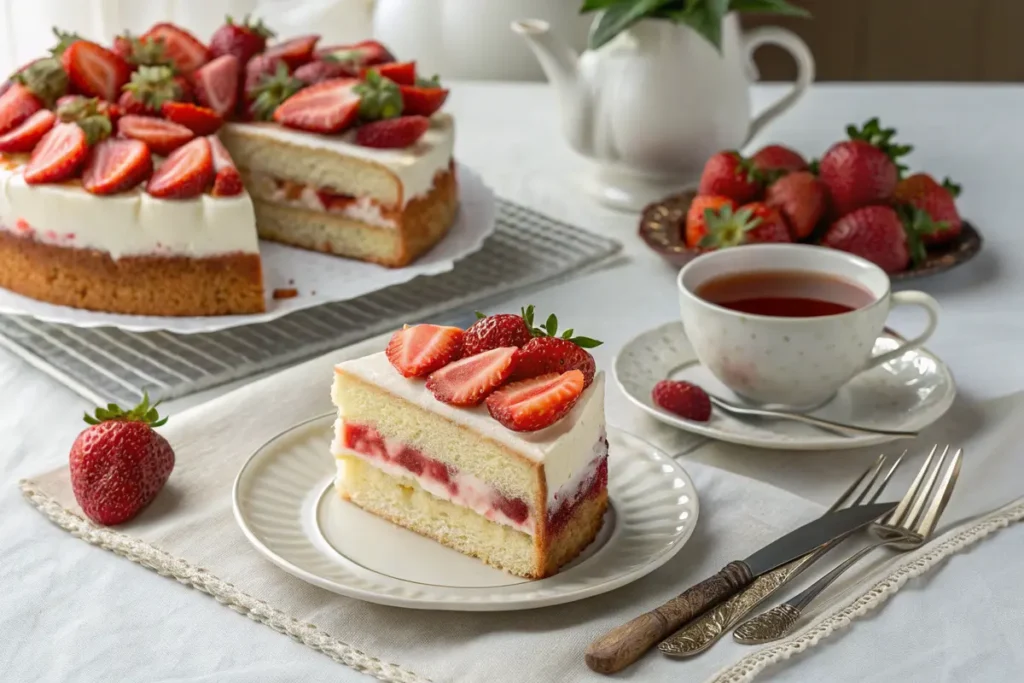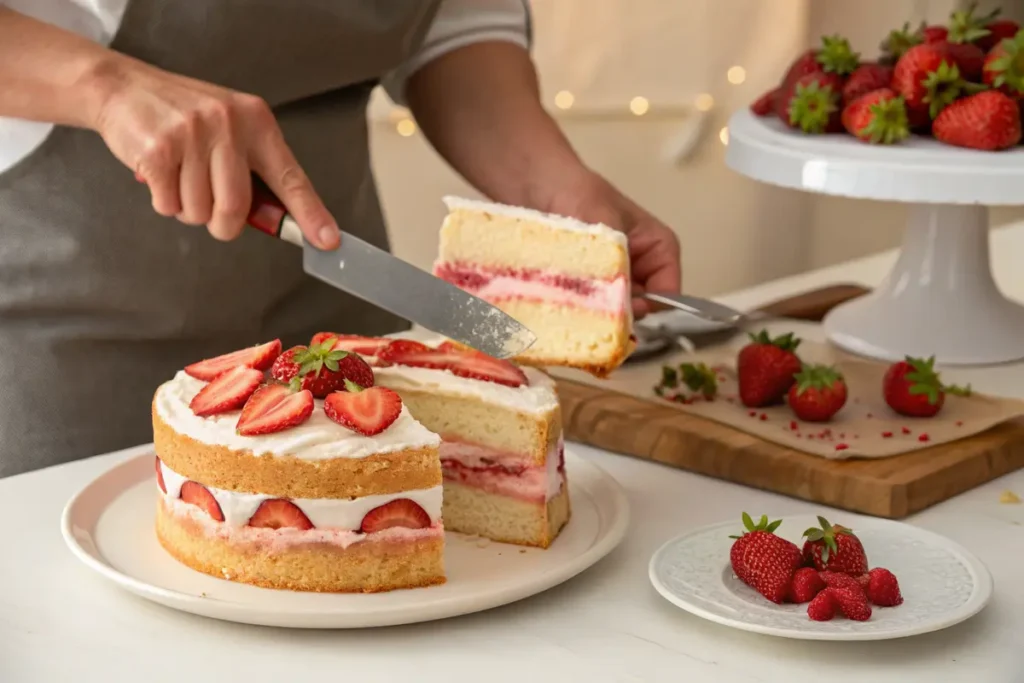Table of Contents
Strawberries sponges cakes add a bright burst of color to any dessert. However, pairing them with a soft, airy crumb can make each bite even more satisfying. Strawberry sponge cake excels at balancing fruity sweetness with a feathery texture. Many home bakers enjoy it because the steps are uncomplicated. Indeed, this cake looks lovely and remains surprisingly simple to create. In this guide, we will review its history, list the must-have ingredients, and share exact baking steps. Eventually, you will see how to get that perfect, spongy feel. By the end, you will also learn decoration ideas and fun ways to change flavors. Whether you want to surprise guests or indulge yourself, a strawberry sponge cake fits the occasion.
How Strawberry Sponge Cake Became Popular

Sponge cakes have existed for a very long time. In the past, people liked them for their airy rise, achieved by whisking eggs by hand. Over time, tools improved, and flours became better, helping the process along. Eventually, home cooks started adding fruit fillings or whipped cream for variety. Strawberries stood out for their vivid color and sweet taste. Hence, a normal sponge cake felt more special once layers of fresh berries appeared. Furthermore, the short list of ingredients let the fruit’s natural flavor shine. As a result, strawberry sponge cake built a loyal fan base among those seeking a balance of sweetness and tang.
Some trace the strong appeal of sponge cakes back to Victorian customs, where afternoon tea required lighter sweets. Folks enjoyed airy cakes during these mid-day gatherings. Consequently, recipes began to spotlight fruit toppings and airy crumbs. The strawberry version grew in fame because it suggested springtime and garden parties. In time, simpler home methods spread, allowing more people to whip up a tender crumb without advanced skills. Consequently, strawberry sponge cake is now a popular choice for birthdays, potlucks, and special events worldwide.
Why Strawberry Sponge Cake Stands Out
Strawberry sponge cake stands out for many reasons. First, it highlights the bright flavor of fresh strawberries, especially during their peak season. Another factor is its gentle crumb, which comes from whipped eggs. Most sponge recipes skip heavy fats, relying on built-in air bubbles instead. This method produces a cake that stays soft. Meanwhile, the fruit’s natural sweetness keeps each slice interesting. Many also appreciate how a strawberry sponge cake can be customized. Some bakers add jam or cream, while others keep the layers plain. Indeed, the main charm lies in the unity of airy batter and juicy berries.
Likewise, its popularity endures because it fits all ability levels. Novices can make a single-layer version with whipped cream on top. Yet advanced decorators might build multiple tiers with fancy fillings and elegant designs. Either way, the essence is a light, pastel-hued cake. Plus, it suits all seasons. Warm months highlight fresh, red fruit, though some bakers turn to frozen berries in colder times. Regardless, a slice of strawberry sponge cake brings a happy note to any table.
Key Elements of a Strawberry Sponge Cake
- Airy Batter
Whipping eggs is crucial to lock in air. In essence, do not rush this key step. - Fresh Strawberries
Use plump, ripe fruit for the fullest flavor. Slice them neatly or chop them into bits, depending on the texture you want. - Basic Items
A strawberry sponge cake typically requires eggs, flour, sugar, and berries. Some recipes add baking powder or a pinch of salt for stability. - Gentle Folding
When blending flour into whipped eggs, do not stir aggressively. Soft folding keeps the air pockets safe.
These factors decide whether your cake is average or outstanding. Master them, and you can adapt different sponge styles later.
Essential Ingredients for a Perfect Strawberry Sponge Cake
To achieve a light crumb and fruity taste, start with good components. Arrange these eight items in order for consistent results:
- All-Purpose Flour (1½ cups)
- Forms the main structure of the batter
- Granulated Sugar (1 cup)
- Sweetens the sponge and helps trap air
- Large Eggs (4 total)
- Provide shape and volume
- Baking Powder (1 teaspoon)
- Aids the cake’s rise and consistency
- Salt (¼ teaspoon)
- Balances sugar and supports flavor
- Milk (⅓ cup)
- Adds moisture, yielding a softer crumb
- Butter, Melted (2 tablespoons)
- Contributes some richness without weighing down the cake
- Strawberries (1½ cups, fresh, sliced)
- Gives a juicy layer and bright color
By placing these elements in this sequence, you can move swiftly during baking. Each item has a specific task. Avoid switching or skipping them unless you have a clear reason.
How to Assemble Your Strawberry Sponge Cake
Though the method is simple, take care at each stage. Follow these steps:
- Warm the Oven
- Preheat to 350°F (175°C). Line two round cake pans with parchment and grease them lightly.
- Whip the Eggs
- Put four large eggs and sugar in a mixing bowl. Beat on high speed for about five minutes. The mix should look pale and drip in ribbons when you lift the whisk.
- Add the Dry Mix
- In another bowl, combine flour, baking powder, and salt. Sift onto the egg foam. Gently fold with a spatula until the batter is smooth. Avoid rough stirring.
- Combine Liquids
- Warm the milk slightly, then stir in melted butter. Pour this around the bowl’s edges. Fold carefully so your batter remains full of air.
- Bake the Layers
- Distribute the batter evenly between the pans. Bake about 20 to 25 minutes, or until a light press on top bounces back. A toothpick inserted in the middle should come out dry.
- Cool Down
- Let the cakes sit for 10 minutes in their pans, then flip them onto a rack. Fully cool before stacking or you risk a collapse or sticky surface.
By following this progression, you protect the airiness that strawberry sponge cake demands. Each step supports an easy, gentle approach to preserve the foam.
Tips for a Flawless Strawberry Sponge Cake
A strawberry sponge cake may seem uncomplicated, but small errors can affect the result. Consider the following:
- Check Egg Quality: Fresher eggs whip better, creating stronger foam.
- Stop Overmixing: Once the batter looks uniform, do not keep stirring.
- Room-Temperature Items: Warmer eggs and milk combine more smoothly, aiding volume.
- Turn Pans if Needed: If your oven has hot spots, rotate the pans halfway. This helps even out any browning.
- Cool Thoroughly: If you add toppings while the cake is hot, frostings can melt, spoiling the final look.
These suggestions boost your chances of baking an airy, good-looking cake. Afterward, you can try different garnishes once you master these basics.
Decorating Ideas for Strawberry Sponge Cake
Personalizing a strawberry sponge cake shows off your style. Many people enjoy a whipped cream filling between the layers, then scatter sliced strawberries on top. You can also try:
- Cream Cheese Icing: Mix softened butter, cream cheese, powdered sugar, and a dash of vanilla. Spread for a richer feel.
- Chocolate Drizzle: Melt semisweet chocolate with a touch of cream. Drip lines across the surface or let it drip over the sides.
- Fresh Herbs: Small mint leaves or basil sprigs add color and an herbal twist.
- Simple Powdered Sugar: Dust a little for an elegant, understated effect.
Ultimately, you can stick to minimal decoration or opt for something elaborate. The cake’s mild flavor base lets you experiment with sweet or tangy highlights. Just keep in mind the strawberries’ bright role.
Flavor Variations and Substitutions
While strawberry sponge cake is a classic, sometimes you want new twists. Think about these:
- Berry Combo
- Mix raspberries or blueberries with your strawberries. This can boost both color and taste.
- Jam Layer
- Spread some strawberry jam in the middle for extra sweetness and ensure fruit in each bite.
- Almond Essence
- Swap half the vanilla for almond extract. This slight tweak adds a gentle, nutty backdrop.
- Gluten-Free Adaptation
- Replace regular flour with a trusted gluten-free mix. Make sure your other items, like baking powder, are also GF-compliant.
- Non-Dairy
- Use plant-based milk and margarine or coconut oil. Eggs still hold the foam, so it is doable.
Such tweaks let you cater to different diets or personal preferences while keeping that distinctive spongy crumb. Meanwhile, strawberries remain the unifying theme, ensuring a pleasant fruit flavor. Playing with scents or fillings keeps the dessert new for returning fans.
Serving Suggestions and Pairings

A strawberry sponge cake is known for its gentle sweetness, so consider mild or creamy pairings. For instance:
- Ice Cream Scoops: Add a cold, milky aspect for a pleasant textural contrast.
- Coffee or Tea: A warm drink helps balance the sweet notes.
- Sparkling Juice or Wine: If it’s a party, light bubbly beverages pair well with fresh berry hints.
- Extra Fruit Platter: Stick to the berry theme by serving more fruit on the side.
These accompaniments keep the dessert from feeling too sugary. Because the sponge is so airy, having an extra slice seldom feels heavy. That’s a key part of its ongoing appeal.
Common Mistakes to Avoid
Everyone slips up sometimes. However, these pointers can help prevent issues with your strawberry sponge cake:
- Underwhipped Eggs: If you do not incorporate enough air early, expect a flat, heavy cake.
- Excess Baking Time: A dry sponge lacks that delicate crumb, so watch the final minutes.
- Adding Berries Too Soon: Stirring fruit right into the batter may weigh it down. Instead, place slices between layers or fold them in carefully at the end.
- Omitting Stabilizers: Some skip salt or baking powder, but these small additions give structure and taste.
- Frosting Hot Layers: Doing this leads to melting or runny fillings, which can ruin the design and texture.
When you take the time to handle these details, you will get a sponge that’s both good-looking and delicious. Once you have perfected the basics, the rest becomes quite flexible.
Conclusion
A strawberry sponge cake reflects all that is best about fresh, fruity desserts. It merges airy layers with bright, juicy berries, producing a dish both gentle and satisfying. Moreover, you can modify the core method by playing with flavors, from jam fillings to different extracts. Because the process depends on basic baking steps, it caters to both new and experienced cooks. Indeed, once you master egg-whipping and folding, you can craft a memorable treat.
If you want a tasty addition to your dessert menu, consider this classic. Its few ingredients show that fresh produce and decent technique can make something special. Furthermore, seasonal changes let you highlight whatever berries you can find. During hotter months, fresh strawberries truly shine. During cooler months, jam or frozen fruit can do the trick. Ultimately, a strawberry sponge cake combines old-fashioned charm with a modern flair, proving that dessert can be both simple and impressive.
Frequently Asked Questions
What is the secret to a good sponge cake?
In essence, a good sponge needs adequate air in the batter. Whip eggs and sugar thoroughly to trap air, then fold in dry items carefully. Use the right baking temperature so the cake rises evenly. Another factor involves using fresh, room-temperature ingredients. Strawberry sponge cake also relies on gentle handling, as too much force can deflate the batter. Altogether, technique and a bit of patience are key to a fluffy texture.
Why is it called a sponge cake?
Basically, it is named for its spongy interior. Older sponge cakes used no chemical leavener and only depended on beating eggs to add air. The result was a porous structure that could soak up fruit or cream easily. Hence, the word “sponge” points to how this cake can absorb liquids. Modern versions sometimes include baking powder, but the general concept of a light, airy crumb endures. This same idea applies in a strawberry sponge cake, where the fruit juices complement the springy layers.
Where did strawberry cake originate?
Strawberry-based cakes pop up in many cuisines, yet some say British bakers helped popularize it during Victorian times. Afternoon teas needed dainty sweets, so pairing airy sponges with fresh strawberries was ideal. Over time, these recipes crossed borders, with each place adding regional spins. Now, strawberry sponge cake is celebrated worldwide, connecting varied baking traditions.
Why is my strawberry cake so dense?
Dense results often tie to underwhipped eggs or overmixing. If you do not gain enough volume in the egg foam, the cake will not rise as planned. Another cause might be too much added moisture from fruit purees, especially if introduced too early. Also, cold items can hinder the batter’s lift, creating a thicker crumb. For a strawberry sponge cake, carefully manage each step: whip eggs properly, fold gently, and only add fruit at a suitable moment.
For more delecious recipes :

